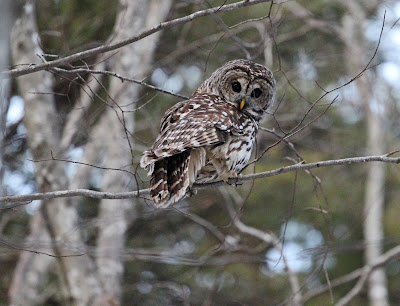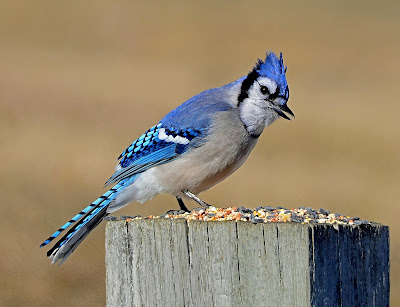Why the increase in barred owl injuries?
I visited the Center for Wildlife in Cape Neddick last week because I had heard about an influx of wounded barred owls and was curious to find out why this was happening. According to Kristen Lamb (executive director of the CFW) four barred owls have been brought in over the past few weeks, as well as a handful more in December, more than were brought in last year. This uptick in injured owls seems to be happening throughout New England. Kristen said when she started asking around she found that other wildlife centers have seen more injured owls this year, for instance the Tufts Wildlife Clinic has admitted 18 barred owls in the past couple months.
 |
| Barred owl looking back at us by Erin Tuveson Earth Trek Photography |
Wildlife rehabilitation centers have seen upswings like this before - back in 2008 and 2010 the number of admitted owls was even higher than this year. It isn't always clear why this happens. Knowing a little bit about barred owl natural history can give us hints.
The majority of animal intakes into wildlife centers in the winter are raptors and adult mammals. This makes sense: the smaller mammals are roaming about under the snow (in the subnivean zone), many birds have migrated south and amphibians as well as some mammals are hibernating. This leaves the resident raptors (owls and hawks) and some of the larger mammals (like raccoons and foxes and weasels) that hunt and forage all winter.
 |
| Barred owl being released after recovering from eye injury photo by Erin Tuveson of Earth Trek Photography |
Barred owls don't migrate, they stick around all winter relying on rodents - mice, woodrats and voles. They can't really handle squirrels - the average weight of an adult barred owl is a mere 1.25 pounds. For comparison a great horned owl, which can eat squirrels, can reach 4 or 5 pounds! In fact, great horned owls are the most serious predatory threat to barred owls (Cornell Lab of Ornithology).
What happens in winter that probably increases the numbers of barred owls admitted to wildlife centers is a result of a shift in their diet and increased hunting along roads. According to Kristen at least 95 percent of raptors injuries seen by the Center for Wildlife in winter are caused by human activities, with cars at the top of the list. Barred owls prefer to hunt in wooded wetlands and vernal pools. In the spring, summer and fall, they eat lots of salamanders and frogs and are key top predators in these ecosystems, intimately tied to vernal pool and wetland ecology. Salamanders and frogs generally hibernate during the winter either under the leaf litter or at the bottom of ponds. So, the barred owl switches to rodents in the winter. Most rodents will take advantage of snow cover by tunneling underneath it, spending winter in the relative protection of the subnivean zone. Roads and roadsides generally lack snow cover in winter, making this easier hunting ground for the owls. Human trash along roadsides attracts rodents, which attracts owls, which makes it much more likely for owls to get hit by cars. This is why it is essential that we don't litter and don't inadvertently litter by allowing trash to blow out of the backs of trucks.
Kristen didn't know why there are more injured owls this year, we may never know, causes can be complex. As illustration of this complexity, one hypothesis for the influx of barred owls in 2008 involves a convoluted chain of events. A late thaw in Canada affected seed production of the food source of the red-backed vole causing their population to plummet. Red-backed voles are a primary food source of barred owls, with fewer red-backed voles available the Canadian barred owls might have been forced south in search of prey.
The current increase in barred owl injuries does correspond with increasing development in this region, so that could be a factor. According to Kristen "while there are so many factors that can go into an increase in numbers, CFW has seen a sharp increase in admissions overall (not just in winter) in the past 2 years, and we do know that there has been a sharp increase in development in the region due to the housing boom. It will all tease out over time."



Comments
Post a Comment